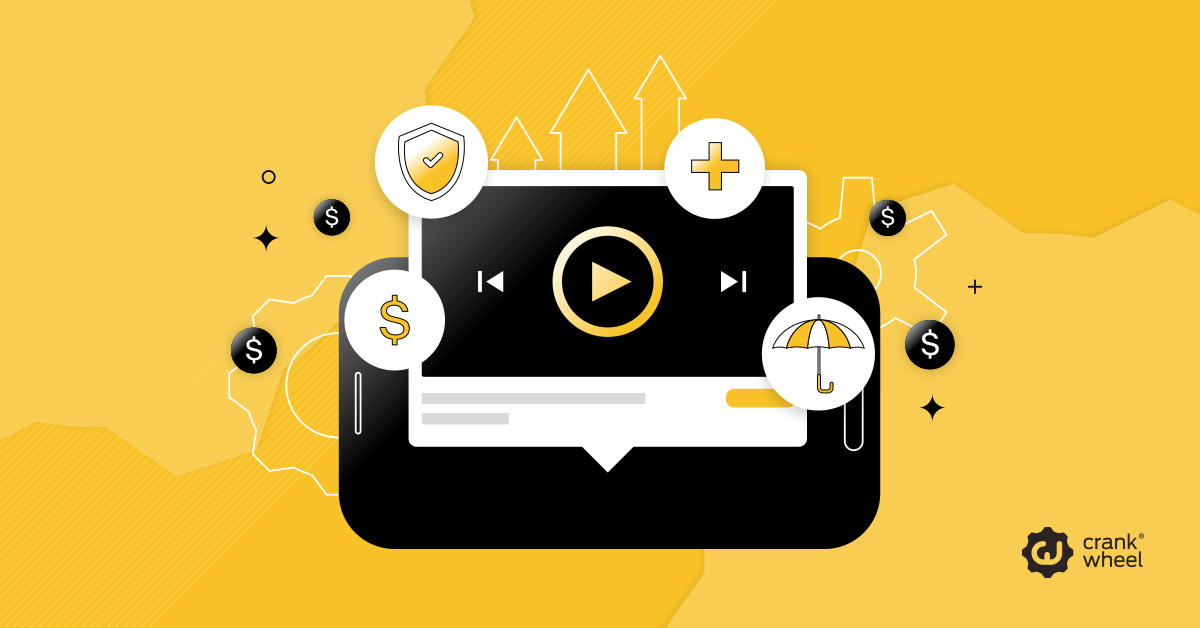Utilizing Video Content to Boost Insurance Sales Engagement
Warm insurance leads are tough to find, and video content can be a game-changer for generating leads that convert. Considering that 88% of video marketers said video has helped them with lead generation, it’s worthwhile to consider adding video marketing to your digital marketing strategy (Wyzowl).

Sales engagement is a critical component of insurance sales activities. Engaged customers are more likely to share their pain points, opening up opportunities for you to turn warm leads into hot leads.
This post will enlighten you as to the power of video content as an insurance marketing tool by describing how to use video marketing effectively and where to use it in your sales funnel. We’ll also review best practices for creating sales videos and how to leverage videos with screen sharing.
Shortcuts
Why Video Works in Insurance Sales
Video Marketing vs. Traditional Sales Materials
Types of Sales Videos and How to Use Them
Best Practices for Creating Insurance Sales Videos
Start Building Your Video Content Library Today
Why Video Works in Insurance Sales
Statistics have shown that video marketing has proven its worth. That success, surprisingly, can be attributed to behavioral science. Videos impact our brains, altering our perceptions. A customer’s thoughts and feelings impact their trust levels, and trust impacts their purchasing decisions.
Take a look at these additional statistics from Wyzowl that clearly demonstrate how much success video marketers are having with video.
- 62% of video marketers quantify ROI through video views.
- 49% of video marketers quantify ROI through leads and clicks.
- 40% of video marketers quantify ROI through brand awareness and public relations.
- 36% of video marketers quantify ROI through customer engagement and retention.
- 30% of video marketers quantify ROI through bottom-line sales.
- 84% of video marketers say video has directly increased sales.
The Psychology of Visual Content for Insurance Sales
Images and videos tap into our core psychological thinking. That concept is important for insurance sales, because it affects us in three ways:
- Whether we pay attention
- What we remember
- Our emotional state
According to the International Forum of Visual Practitioners, whenever you see an image or watch a video, your brain processes the information 60,000 times faster than if you read something about it.
This means that if you can capture someone’s attention with an image or video, the brain automatically deposits it in the viewer’s short-term memory bank.
Emotionally charged visuals trigger even stronger responses from the brain.
Videos that tug at the viewer’s emotions deepen engagement. By creating videos with dynamic scenes and the actors responding with deep expressions, viewers will be eager to know what’s next.
Overall, video content resonates with insurance customers, making it a powerful tool to compel persuasion and decision-making.
Video’s Impact on Trust and Decision-Making
For a moment, reflect on how you feel when you watch a video where someone is speaking about how insurance changed their life for the better.
It’s believable, right? Since a real person is speaking, the video feels authentic. This personal connection helps reduce skepticism, fosters trust, and reduces barriers to a sale.
Video Marketing vs. Traditional Sales Materials
While traditional marketing materials can be valuable in some respects, digital marketing has taken center stage with insurance as it typically outperforms static materials. Video content is an essential component of modern digital marketing strategies due to its persuasive power and ability to drive conversions.
Traditional insurance sales materials, such as postcards and brochures, still play a role in the sales process. Nevertheless, video prospecting offers distinct advantages in today’s fast-paced, digital-first landscape.
Insurance salespeople have long used paper materials to communicate information and highlight product features. While these tools are nice to send and leave behind after a sales appointment, customers can easily put them aside and forget them.
By contrast, videos engage more of the viewers’ senses, drawing them more deeply into the experience. In essence, your insurance videos allow them to see, hear, and feel your brand.
With the aid of sound and visuals, videos deliver an impactful story efficiently, often in a few minutes. You can create videos for every stage of the insurance sales process, from awareness to your follow-ups after the sale.
Shareability is a key advantage of videos. You can easily store them and share them across various digital platforms. Viewers can play them on demand using their preferred device.
Types of Sales Videos and How to Use Them
Different types of videos will help you reach different outcomes, depending on the stage your audience is in and your sales objective.
Here, we describe several types of marketing videos and their benefits:
- Explainer videos: Use to simplify complex topics to garner interest and get viewers wanting to know more.
- Product demos: Use to highlight features and show precisely how a product provides value in everyday living.
- Customer testimonials: Use to overcome buyer objections and create social proof that consumers can trust your brand.
- Personalized prospecting videos: Use to break through the inbox noise, capture the prospect’s attention, and build strong connections faster.
- FAQ or objection-handling videos: Use to improve buyer confidence and build trust through transparency.
- Webinars and live Q\&As: Use to build authority and engage customers with live interactions.
Where and How to Use Video Across the Sales Funnel
In addition to creating the most appropriate type of video for your purposes, it’s also essential to gear your message according to the sales funnel stage.
Below, we’ve outlined each funnel stage and the best types of videos to produce in each stage:
- Top of Funnel: Brand awareness videos, educational videos, how-to videos, and social media teasers. Capture the viewers’ attention and ignite interest. Keep them short and engaging.
- Middle of Funnel: Product explainer videos, case studies, product demonstrations, tutorials, and webinars. Educate viewers and keep them wanting to know more. Go more in-depth with features and benefits, target solutions, and include testimonials.
- Bottom of Funnel: Personalized video messages, detailed demos, onboarding previews, comparison videos, and more testimonials. Address individual needs, walk through products, showcase customer successes, and highlight the return on investment.
You can get even more value from videos when you use them in follow-ups to ensure customer satisfaction.
Best Practices for Creating Insurance Sales Videos
When setting up your video content marketing strategy, it’s important to be crystal clear on what you’re trying to accomplish.
These are some things to consider:
- Who is your target audience?
- What stage of the sales funnel is the audience in?
- Is your goal to introduce a product or service?
- Is your goal to answer common objections?
- Does your audience need more information?
- Is your audience ready to convert?
- How does your product/service differentiate from the competition?
With these questions in mind, the next step is to do some brainstorming about what story your video should tell. Will your story translate better with text and images or with real people speaking?
Here are some great tips for creating storytelling through video:
- Use a strong hook right from the start.
- Focus on features first and benefits next.
- Speak directly to the viewer’s pain points.
- Connect their pain points to your solution.
- Include a clear call-to-action with clear next steps.
- Add captions, as people often view videos without sound.
- Use good lighting and quality sound for a professional-looking video.
- Optimize your video for mobile viewing.
- Keep your video short, preferably under two minutes.
In relation to the first bullet point, Wyzowl’s research shows that the most effective length for marketing videos is between 30 seconds and two minutes.
These best practices for creating sales videos will help keep your viewers tuned in and wanting to know more.
After creating your sales videos, you’ll need to decide where to use them. Put them on your website and social media platforms and use them in your email campaigns.
With CrankWheel’s screen-sharing software, you can use your insurance videos during in-person or virtual sales.
The CrankWheel Advantage
The concept behind CrankWheel was clear – to simplify sales calls and demos. This tool streamlines the sales process, making it more efficient for salespeople and their customers.
CrankWheel’s software includes the following features:
- Records your screen and shares it
- Monitors engagement and open rates
- Gives options for which part of the screen to share
- Allows you to toggle your webcam on or off
- Enables you to send follow-up emails with an animated preview
- Facilitates sharing videos via SMS or instant messages
Screen-sharing adds a new dimension to your insurance sales calls. You can share them on the spot during your presentations or in your email threads.
A video is more compelling for a prospect to click on than merely skimming over your written content. With CrankWheel, you get a crisp, HD video with clear sound. The audio and video align perfectly, and you won’t have to worry about choppy playback.
With CrankWheel, you have complete control over what you and your sales teams can share. The administrator selects which videos can be shared, so there’s no confusion about customer-facing videos.
Insurance salespeople can select the best video to use for their purpose. All they have to do is select a video from the list and share it. They can share a program window, a tab, or their entire screen.
On the back end, you can integrate CrankWheel with your Google Analytics account to track events and create reports.
Your dashboard will give you insights into:
- Top landing page views
- Conversions
- User behavior
You will even get notifications when viewers have watched your videos and you can see how many minutes of the videos they watched. You’ll also get notifications when viewers play videos back.
Screen-sharing builds trust within the first few seconds of your interactions with customers, which is crucial for prepping prospects to convert.
When it all works as planned, you can shorten your sales cycle. You might even close the sale on your first call.
Start Building Your Video Content Library Today
As you can see from the statistics we highlighted earlier, the percentage of salespeople who are having great success with using sales videos is quite high.
That said, building a video content library takes time and effort. We encourage you to start with one or two video formats and track your results to see which work best for you. By continually adding to your insurance video library over time, you’ll have many choices in how to reach your target audiences. As you gain expertise in creating videos, you’ll learn how to effectively integrate them with your CRM, email campaigns, and landing pages.
This approach will allow you to analyze your results over time without overwhelming you or your sales teams. You might even find that creating sales videos and tracking your results is fun.
Screen-sharing software allows you to share pre-recorded sales videos quickly and easily. Share all or part of your screen and monitor your engagement and open rates. Send your videos in email strings with an animated preview.
Contact CrankWheel today to see how you can get started sending personalized videos to your prospects and customers. Or start a free trial and see how CrankWheel’s browser-based screen sharing works for yourself!
